the 2007 Abstract Presentations - Wound Healing Society
the 2007 Abstract Presentations - Wound Healing Society
the 2007 Abstract Presentations - Wound Healing Society
Create successful ePaper yourself
Turn your PDF publications into a flip-book with our unique Google optimized e-Paper software.
<strong>Abstract</strong>s<br />
41<br />
BFGF GENE TRANSFER BY ADENO-ASSOCIATED VIRAL 2<br />
VECTORS DECREASES WORK OF ACTIVE DIGITAL<br />
FLEXION AND ADHESION FORMATION: AN IN VIVO<br />
STUDY UP TO END TENDON HEALING STAGE<br />
Yi Cao, MD, Bei Zhu, MD, Ke-Qin Xin, MD, PhD, Xiao Tian Wang, MD,<br />
Paul Y. Liu, MD, Jin Bo Tang MD<br />
Department of Hand Surgery, Nantong University, China, Roger Williams<br />
Hospital, Providence, RI<br />
Purpose: Previously, we demonstrated that adeno-associated virus-2 (AAV2)<br />
mediated gene transfer promotes expression of collagen genes associated with<br />
tendon healing process in tenocytes and enhanced healing strength at 4 weeks<br />
post-surgery. In this study, we propose to investigate effects of delivery of <strong>the</strong><br />
bFGF gene to injured flexor tendon in a clinically relevant injury model on<br />
several ultimate outcome measures at end tendon healing stage—ultimate<br />
gliding function, work of active digital flexion and extent of matured adhesions.<br />
Methods: We used 20 long toes from 10 white leghorn chickens. These toes<br />
were randomly divided into 2 groups of 10 each. The flexor digitorum<br />
profundus (FDP) tendons were cut completely in zone 2 and were repaired<br />
with modified Kessler method. In AAV2-bFGF group, a total of 2 10 9<br />
particles of AAV2 harboring <strong>the</strong> bFGF gene were injected to both stumps of<br />
<strong>the</strong> cut tendon ends before repair. In non-treatment group, <strong>the</strong> tendons were<br />
repaired by <strong>the</strong> same method, but no injection was given. The operated toes<br />
were immobilized in semiflexion position over initial 3 weeks and were released<br />
to allow free motion <strong>the</strong>reafter. At <strong>the</strong> end of 12 weeks, <strong>the</strong> toes were harvested<br />
and <strong>the</strong> energyrequired to actively flex <strong>the</strong> toe (work of flexion) was tested in a<br />
tensile testing machine (Instron). Gliding excursion of <strong>the</strong> repaired FDP tendon<br />
was measured under a load of 10 N. The extent of peritendinous adhesions was<br />
recorded according to scoring criteria.<br />
Results: The work of flexion of <strong>the</strong> toes in <strong>the</strong> AAV2-bFGF treatment group<br />
(0.021 0.006 J) was significantly less than that of non-treatment controls<br />
(0.033 0.015 J) (p o 0.05). The gliding excursion of <strong>the</strong> AAV2-bFGF treated<br />
FDP tendons was not significantly changed compared with that of <strong>the</strong> tendons in<br />
non-treatment group. Adhesion scores of <strong>the</strong> AAV2-bFGF group (2.8 0.7 points)<br />
were significantly less than those of <strong>the</strong> control tendons (3.8 0.9 points) (p o 0.05).<br />
Conclusions: bFGF gene transfer via AAV2 vectors to digital flexor tendon<br />
significantly decreases energy required to flex <strong>the</strong> digits and adhesion formations.<br />
We evaluated <strong>the</strong> outcomes at <strong>the</strong> end stage when adhesions and healing<br />
had matured and function was steady. These findings suggest that delivery of<br />
bFGF gene through AAV2 has advantage of decreasing adhesion formation<br />
during tendon healing process and benefits ultimate digital motion.<br />
42<br />
FIBROBLAST GROWTH FACTOR-2 IMPROVES THE<br />
QUALITY OF LOWER EXTREMITY WOUND HEALING<br />
Sadanori Akita 1 , Kozo Akino 2 , Akiyoshi Hirano 1<br />
1 Dept. of Plastic Surgery, Nagasaki University,<br />
2 Dept. of Neuroanatomy, Nagasaki University<br />
The reconstruction of lower extremity is difficult when <strong>the</strong> patients are elderly<br />
and with severe basic diseases such as cardiac, metabolic and vascular diseases.<br />
Fibroblast growth factor-2 (FGF-2) is a stimulator of <strong>the</strong> quality of wound<br />
healing in 3 rd and 2 nd degree burn wounds as well as a potent angiogenic factor.<br />
On <strong>the</strong> o<strong>the</strong>r hand, <strong>the</strong>re are more clinical merits of using an artificial dermis for<br />
promoting wound bed preparation in difficult wound healing of <strong>the</strong> lower<br />
extremities. We previously demonstrated <strong>the</strong> successful serial artificial dermis<br />
and secondary thin split-thickness skin grafting. Here <strong>the</strong> combination of FGF-2<br />
and artificial dermis with secondary split-thickness skin grafting was subjected to<br />
historical comparative analysis with similar age, follow-up period and duration<br />
to and thickness of <strong>the</strong> secondary skin. The average age of 66.5 years of 12<br />
patients with at least half a year of post-complete healing (2.0 0.8 years) was<br />
used daily FGF-2 at 1 m g/cm 2 until secondary skin grafting. The skin hardness<br />
demonstrated by a durometer (TECLOCK, Co., Ltd, Nagano, Japan) was<br />
significantly less hard in FGF-treated scars than in non-FGF-2 treatment<br />
(16.2 3.8 vs. 29.2 4.9, P o 0.01). The corneal layer (stratum corneum)<br />
parameters indicated by effective contact coefficient, transepidermal water loss<br />
(TEWL), water content and thickness were all significantly greater in non-FGFs<br />
treatment than in FGF-2 treatment detected by a transportable moisture meter<br />
(ASA-M2, Asahi Biomed, Co., Ltd, Yokohama, Japan) (contact coefficient;<br />
10.9 1.05%, 17.9 1.95%, p o 0.01, TEWL; 13.2 2.16 g/m 2 /h, 21.2 2.93 g/<br />
m 2 /h, p o 0.01, water content; 24.7 5.06 mS, 46.0 5.67 mS, p o 0.01, thickness;<br />
12.1 3.14 mm, 17.2 1.87 mm, p o 0.01, FGF-2 treated, non-FGF-2<br />
treated, respectively). These results suggest that daily FGF-2 treatment until<br />
immediately before secondary split-thickness skin grafting demonstrates better<br />
quality of wound healing in term of hardness and corneal barrier function.<br />
43<br />
CELL BIOLOGY AND MOLECULAR MECHANISMS OF<br />
INSULIN-INDUCED ACCELERATION OF HEALING<br />
Yan Liu, Min Yao<br />
Manuela Martins-Green Department of Cell Biology and Neuroscience,<br />
University of California, Riverside, CA 92521<br />
As a dynamic, interactive and complex process, wound healing involves<br />
inflammation, granulation tissue formation, re-epi<strong>the</strong>lialization and tissue<br />
remodeling. Governed by <strong>the</strong> local production of cytokines and growth factors,<br />
keratinocytes and endo<strong>the</strong>lial cells proliferate, migrate and differentiate to<br />
achieve re-epi<strong>the</strong>lialization and angiogenesis respectively. We have investigated<br />
<strong>the</strong> topical application of insulin and find that it significantly enhances <strong>the</strong><br />
wound healing process in vivo. To determine <strong>the</strong> cell and molecular basis of<br />
insulin acceleration of healing, we studied <strong>the</strong> effects of this protein on<br />
keratinocytes and endo<strong>the</strong>lial cells (EC). Insulin stimulates keratinocyte proliferation<br />
and migration in a dose- and time-dependent manner and it does so<br />
independently of EGF/EGFR. This stimulation is dependent on activation of<br />
Akt, PI-3 K and sterol regulatory element binding proteins (SREBPs). The<br />
effect of insulin on EC results in stimulation of EC migration but does not affect<br />
proliferation and <strong>the</strong> effect on migration is independent of VEGF. In EC,<br />
insulin stimulates phosphorylation of Akt and ERK1/2 in a dose- and timedependent<br />
manner, but only Akt is involved in <strong>the</strong> effect of insulin on EC<br />
migration. Fur<strong>the</strong>rmore, phosphorylation of Akt induced by insulin decreases<br />
when cells are pre-treated with VEGFR inhibitor SU1498. Our results show<br />
that PI3K- Akt- SREBP are critical molecules in insulin stimulation of<br />
keratinocyte migration/proliferation and in EC migration. Taken toge<strong>the</strong>r,<br />
<strong>the</strong>se results show that insulin is ano<strong>the</strong>r factor that accelerates wound healing<br />
and hence it should be given high consideration as potential treatment for<br />
impaired wounds.<br />
44<br />
THE USE OF RECOMBINANT HUMAN EPIDERMAL<br />
GROWTH FACTOR (RH-EGF) TO PROMOTE HEALING FOR<br />
CHRONIC RADIATION ULCER<br />
Sang Wook Lee 1 , MD PhD, Sue Young Moon 1 , MS, Yeun Hwa Kim, MS,<br />
Joon Pio Hong, MD PhD, MS<br />
Asan Medical Center Univcersity of Ulsan Department of Radiation Oncology<br />
and Plastic Surgery<br />
Purpose: Along with in vitro studies, this case report describes <strong>the</strong> first<br />
successful use of recombinant human epidermal growth factor (rh-EGF) in<br />
radiation induced chronic wound of bone and skin.<br />
Method: Human fibroblasts were primarily cultured and were divided into two<br />
major groups. The non-radiated group was <strong>the</strong>n divided into 5 subgroups;<br />
control and treated with various doses of rhEGF (1 nM, 10 nM, 100 nM, and<br />
1000 nM). The radiated group underwent radiation with 4MV energy <strong>the</strong>rapeutic<br />
linear accelerator (CLINAC 600C, Varian, Palo Alto, CA, USA) at dose<br />
rate of 2 Gy/minute totaling 4 Gy <strong>the</strong>n divided into 5 subgroups; control and<br />
treated with various doses of rhEGF (1.6 nM, 16 nM, 160 nM, 1600 nM). The<br />
cells were <strong>the</strong>n evaluated: 1) MTT assay from day 2 to 7; 2) FACscan was used<br />
to evaluate <strong>the</strong> change in cell cycle. As a case study, a 59-year-old female is<br />
presented with a radiation induced ulceration of <strong>the</strong> chest lasting 3 years<br />
underwent treatment with rh-EGF (Epidermin, Daewoong pharmaceuticals,<br />
Seoul, Korea) with consent.<br />
Result: The results revealed increased numbers of fibroblasts in all subgroups<br />
of radiated group treated with rhEGF compared to <strong>the</strong> control. Cell count at<br />
day 7 showed increasing tendency relative to <strong>the</strong> dosage and <strong>the</strong> highest increase<br />
of 50% was seen in subgroup treated with 160 nm rhEGF (p o 0.05). The<br />
subgroups treated with 1600 nM demonstrated decrease in cell count. Similar<br />
tendency was seen in <strong>the</strong> nonradiated group where 100 nM rhEGF treated<br />
subgroups showed <strong>the</strong> highest increase (p o 0.05). The results of <strong>the</strong> FACscan<br />
showed increase in <strong>the</strong> S-phase of <strong>the</strong> cell cycle. In <strong>the</strong> patient, treatment with<br />
rh-EGF and advanced wound care achieved healing within 16 weeks.<br />
Conclusion: Rh-EGF in treatment against radiation induced ulcer may have<br />
some promising potentials but fur<strong>the</strong>r study is warranted. Fianacial support:<br />
This study was performed with partial grant from Daewoong Pharmaceutical,<br />
Seoul, Korea.<br />
<strong>Wound</strong> Rep Reg (<strong>2007</strong>) 15 A14–A54 c <strong>2007</strong> by <strong>the</strong> <strong>Wound</strong> <strong>Healing</strong> <strong>Society</strong><br />
A25




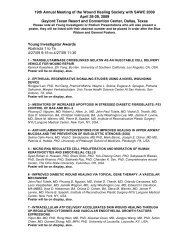

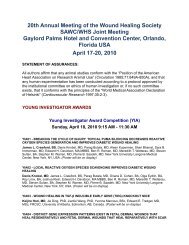
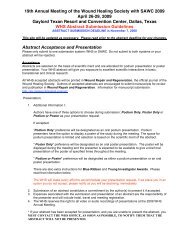
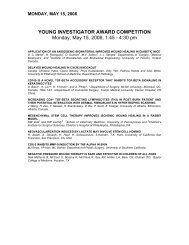

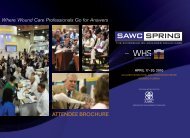

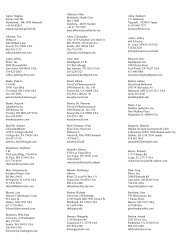
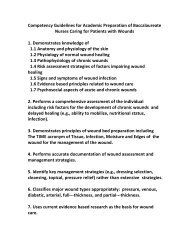
![2010 Abstracts-pah[2] - Wound Healing Society](https://img.yumpu.com/3748463/1/190x245/2010-abstracts-pah2-wound-healing-society.jpg?quality=85)